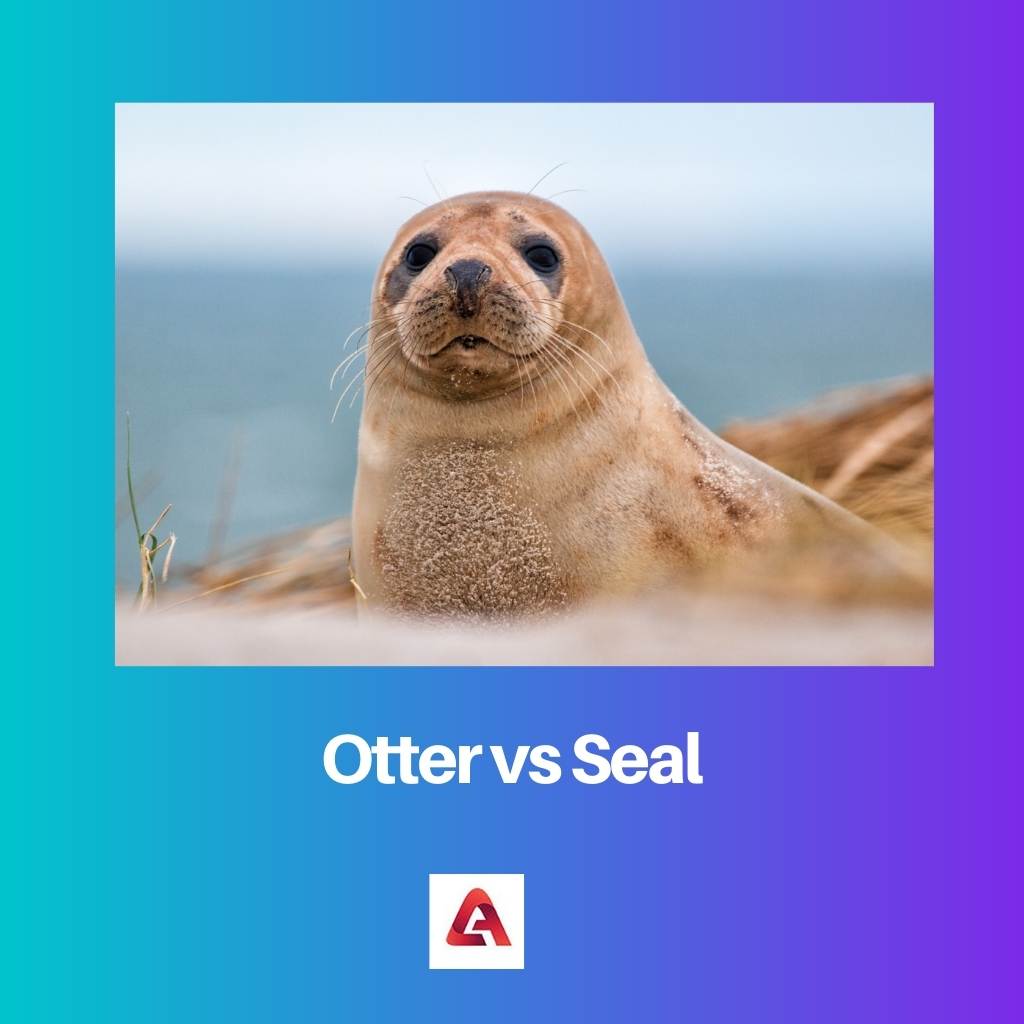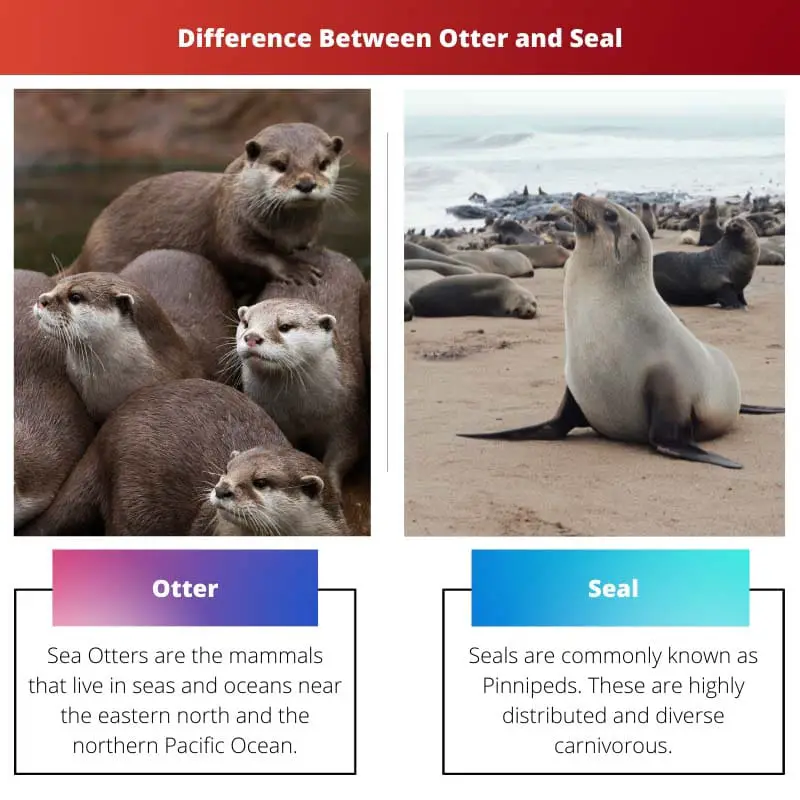There are many sea animals with various features and characteristics in the world. Some are extremely dangerous, some are small and cute, and some are harmless.
Otters and Seals are two of such kinds. Sea Otters and seals share many common things, like both are mammals, but the list of differences is quite long.
The issue is that many people get confused with Otters and seals due to their same-looking physique externally.
Key Takeaways
- Otters have long, streamlined bodies with webbed feet, while seals have round, bulky bodies with flippers.
- Otters primarily eat fish and are found in freshwater and coastal regions, while seals eat fish and other marine life and are found in oceans and beaches.
- Otters are more playful and social, while seals are more solitary and territorial.
Otter vs Seal
Otters are members of the weasel family and are found in both freshwater and saltwater environments around the world. They have sleek, streamlined bodies that are well-suited for swimming. Seals are a type of pinniped and are found in oceans and other saltwater environments around the world. They have a more robust body shape than otters.

A major difference comes into the picture when we see their strategy of keeping themselves warm.
Otters use their dense fur to keep themselves warm, while Seals have a blubber deposit inside their skin.
There are many more differences regarding their physique, features, and habits.
Comparison Table
| Parameter of Comparison | Otter | Seal |
|---|---|---|
| Family | Otter comes from the Mustelidae family. | Seal belongs to the Phocidae family. |
| The strategy of being warm | With the help of their furs. | With the blubber deposit below their skin. |
| Place of Living | Spends most of their time in the water. | Spends most of their time on the land. |
| Food | Otters like having invertebrates. | Fish is the favourite food of Seals. |
| Physical characteristics | Otters have paws and external ears. | Seals have flippers and do not have visible ears. |
| Swimming ability | Otters are good swimmers. | Seals love to swim and are better at swimming than Otters. |
| Gestation Period | The gestation period for Otters is about 60 to 86 days. | Seals have 12 months as their gestation period. |
What is Otter?
Sea Otters are mammals that live in seas and oceans near the eastern North and the northern Pacific Ocean.
A fully-grown sea otter weighs around 14 to 45 kg, making them the heaviest member of the smallest marine animals in the Weasel family.
Unlike other mammals in the ocean, they do not have fat under their skin.
They have a very thick layer of fur over their body to protect them from the cold. This thick layer of fur is the densest in the whole animal kingdom. They can walk but still prefer living in the ocean most of the time.
Below is the Scientific classification of the Otter:
- Kingdom: Animalia
- Phylum: Chordata
- Class: Mammalia
- Order: Carnivora
- Family: Mustelidae
Sea Otters were intensively hunted for their fur quality from around 1700 to 1900, with a great fall in their population. This resulted in an international ban on hunting them via various programs.
It is one of the smallest marine creatures, but it is known for being the heaviest in the Mustelidae family.

What is Seal?
Seals are commonly known as Pinnipeds. These are highly distributed and diverse carnivorous.
There are a total of 33 extant species found for Seals. However, 50-plus extant species are described from the fossils found.
Seals weigh from 45 kg(Baikal Seal) to 3,200 kg(Southern Elephant Seal).
Many species of Seal exhibit Sexual Dimorphism. Seals are highly agile and flexible due to their four limbs and streamlined bodies. These limbs of Seals are modified into flippers.
Below is the Scientific classification of the Seals:
- Kingdom: Animalia
- Phylum: Chordata
- Class: Mammalia
- Order: Carnivora
- Family: Phocidae
Several species of Seals are very amazing at diving into deep oceans.
Seals have a fat layer(blubber) under their skin that keeps them warm inside the cold water. Seals mate and give birth to their young ones on the land. They also come to land to escape from their hunters and predators like sharks.
Indigenous people around the Arctic use the blubber, meat, and fur coats by hunting Seals.
They are sometimes trained to perform various tasks and tricks and are mostly kept in Captivity. They were once brutally hunted for these qualities but now are protected under International law.

Main Differences Between Otter And Seal
- However, both of them are mammals and come from different families.
- Otter belongs to the Mustelidae family, whereas Seal comes from the Phocidae family.
- The technique of keeping themselves warm is also different. Unlike other marine mammals, Otter does not have blubbers and uses their furs to keep themselves warm. On the other hand, Seals use their blubber deposits under their skin to keep them safe from the cold water.
- Otters spend most of their time in the water while Seal roams more on the land. They mate, give birth, and protect themselves from predators by moving to the land.
- Otters are not fish lovers and live by feeding themselves with invertebrates, whereas Seals love fish as their meals.
- Physical characteristics are also different for the two. Otters have paws, while Seals have flippers. Otters have external ears, while Seals’ ears are not visible.
- Both of them are good swimmers. However, Seals are better at swimming than Otters.
- Otters have a gestation period of around 60 to 86 days. On the other hand, Seals have a gestation period of 12 months.




